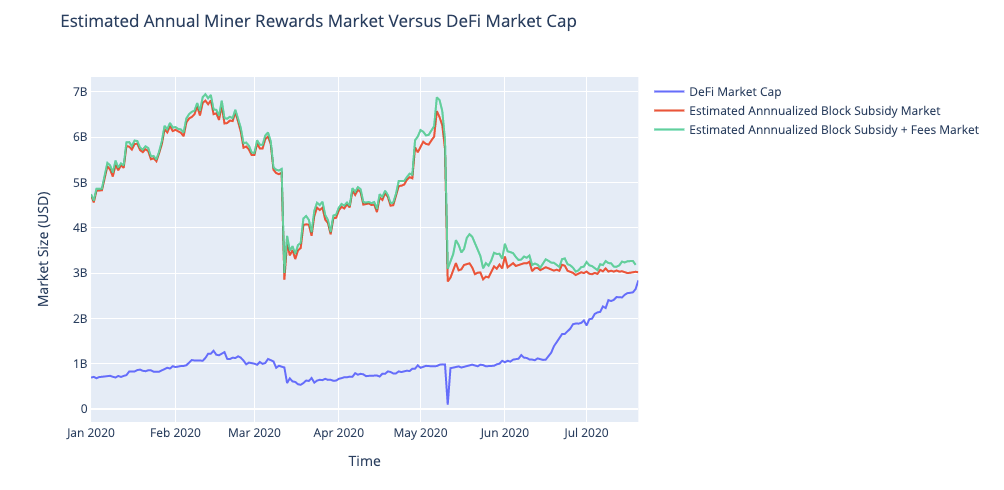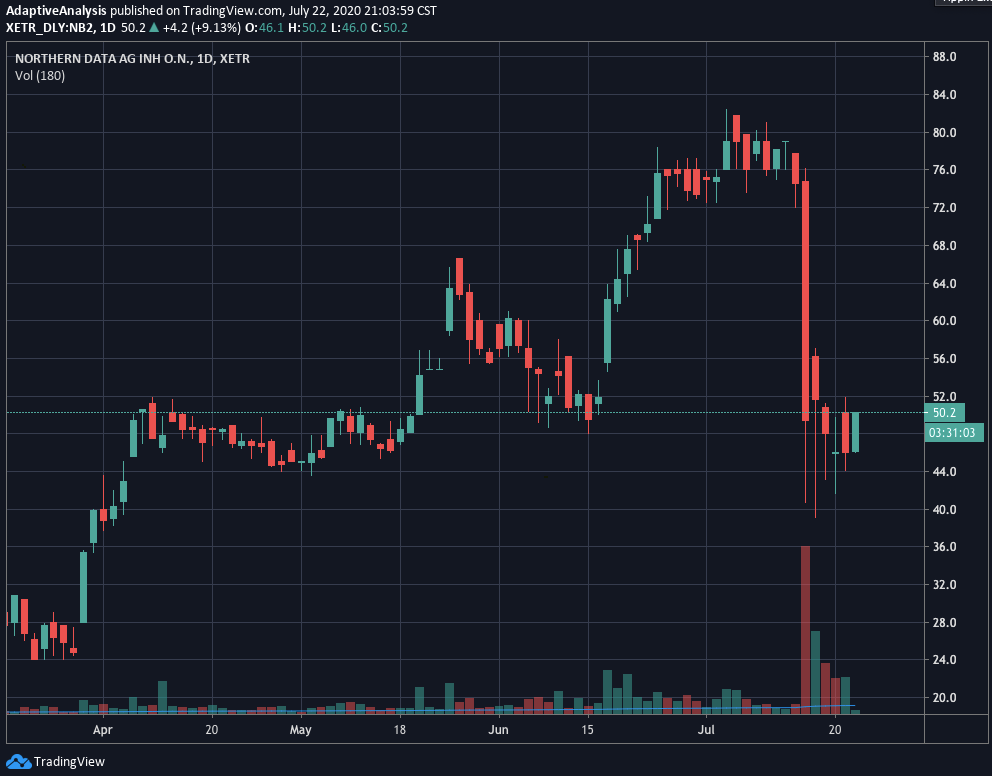In recent weeks, the lion’s share of attention in crypto has been in DeFi. Wild speculation reminiscent of 2017 took centre stage and the value locked in DeFi protocols recorded rapid growth.
As we are writing this piece, the value locked in DeFi protocols is about to overtake the current value of Bitcoin block rewards issued annually. But how sustainable the increase in DeFi is an entirely different matter.
In this week’s cover piece, we analyse the recent developments in DeFi. We highlight the nature of the speculative activity taking place on DeFi protocols and consider how the ecosystem will fare in volatile price conditions. We also cover the latest developments in Bitmain, Zcash, and Northern Data.
We are also excited to announce that HASHR8 has launched a new podcast series – BullishAF! This new series will cover the latest developments in the crypto market and will host the biggest speculators in the game.
The inaugural episode launches with “The Wolf of All Streets” Scott Melker. Scott shares his insights on dogecoin, altseason, and why he believes PayPal will shape the future of decentralized currencies. This one is not to be missed!
The Fragility of DeFi
DeFi has been the dominant discussion point among crypto enthusiasts since mid-June. With valuations of DeFi protocols and their related tokens increasing rapidly, this craze will have severe ramifications for the entire crypto industry.
The DeFi market cap began rapidly rising in mid-June. Spiking popularity around activities termed “yield farming” and “liquidity mining” were important drivers in the increase in DeFi value.
The hype surrounding DeFi has diverted some of the attention away from Bitcoin and the trading volume and volatility would certainly suggest so. For June, Bitcoin recorded its lowest month of trading volume since March 2019.
The total value locked (TVL) in DeFi protocols is also approaching the annualized value of block rewards available to miners. Current estimates for the annualized rewards market available to Bitcoin miners stand at $3.18 billion while the total value locked in DeFi reached $3.05 billion on July 22nd. This suggests that the market for DeFi could shortly become bigger than the market for Bitcoin mining rewards.
The below graph highlights this year’s development of TVL in DeFi versus the estimated annual market for Bitcoin miner rewards. The market for block rewards was calculated by multiplying the daily closing price by the number bitcoin expected to be issued through block rewards in a year. The market for fees was calculated by annualizing the daily total USD fees. The two steep declines correspond to the sharp price drop in March and the May 11th block subsidy halving.
With DeFi looking almost certain to grow bigger than the market for Bitcoin block rewards, it looks likely to detract even further attention from Bitcoin. The success of DeFi has already had an impact on the mining world. The majority of the DeFi ecosystem exists on Ethereum and the hype has driven a spike in activity on the network. This heightened activity has resulted in Ethereum miners enjoying their longest spell earning greater transaction fees than Bitcoin miners. Transaction fees earned by Ethereum miners have been greater than Bitcoin miners since June 6th.
But how sustainable is the heightened activity and significant price increases being observed in DeFi system? It is worth noting that the majority of DeFi projects have never weathered volatile Bitcoin price conditions. Much of the emerging DeFi coins have come to prominence over the past two months. These coins will not have even been tested by Bitcoin’s last bout of significant volatility in May. Even the largest and most liquid protocol MakerDAO which has been around for years has struggled during volatile price periods.
The nature of DeFi makes the system extremely vulnerable to price volatility. DeFi speculators have been employing complex strategies where they use borrowed funds from one protocol to loan on another protocol at a higher interest rate. Furthermore, in many cases, borrowers are being subsidized in the form of the native tokens of protocols. These activities vastly increase the leverage inherent in the DeFi system. Sharp price declines would likely catalyze widespread liquidations. With many of the native tokens of these protocols being used as the collateral for other protocols, the liquidation would easily spread system-wide and the result will almost certainly be extremely ugly.
How fragile the system is to price volatility can easily be assessed by envisioning what happens in the case of price drops. When the price of Bitcoin declines 50%, the estimated block rewards miners receive also drop by roughly 50%. However, difficulty subsequently will adjust and lower the input costs of miners that can survive the drop. In the case that the wider crypto market drops by 50%, the value of much of the assets being used as a collateral in DeFi will be diminished. This will catalyze widespread liquidations and more than 50% of the value in the system will be likely to evaporate.
If we were to classify DeFi and the Bitcoin rewards market according to Nassim Taleb’s spectrum of antifragility (fragile to robust to antifragile), DeFi would certainly be fragile to price movements. When prices drop by a given percentage, a greater percentage is expected to be evaporated from DeFi liquidity. The overall rewards market for Bitcoin miners would be antifragile for those who can stay above breakeven levels during price drops. When difficulty adjusts downward to account for the miners forced offline, those who remain will receive a greater share of the rewards.
“We can almost always detect antifragility (and fragility) using a simple test of asymmetry: anything that has more upside than downside from random events (or certain shocks) is antifragile; the reverse is fragile.”
Nassim Taleb, Antifragile
What Miners are Monitoring
Bitmain hard forks. In a previous newsletter release, we detailed that the likely scenario for Bitmain was Jihan or Micree buying the other out. As it turns out, neither Micree or Jihan want to give up their seat at the table so they have vowed for the hard fork route. The Bitcoin hard fork was messy. The Bitmain hard fork looks destined to be even messier. On July 16th, Jihan Wu established a new Shenzhen entity. This Shenzhen entity will split the supply chain of Bitmain. Some customers have already received letters that significant delays are to be expected for Antminer deliveries.
Zcash Network Upgrade and ASIC. The Zcash network has executed its fourth network upgrade since launching in 2016. The upgrade, called “Heartwood”, allows miners to receive coinbase transactions to a private address which obfuscates information such as the amount. A new ASIC has also been recently released by Bitmain for Zcash’s mining algorithm Equihash. The Antminer Z15 is currently the most profitable mining rig listed on ASICMinerValue. Luxor Mining has reported that a Z15 they acquired has outperformed its advertised hash rate by 5%.
Northern Data letter. Several weeks ago, we assessed the ambitious claims which have been made by publicly-listed Bitcoin mining company Northern Data. We found little evidence to back their statements. The was one of several critiques of the company which has been published in recent weeks. A sharp sell-off in the company share price ensued with a decline from ~$75 to ~$50 being recorded in one day of trading. In response to the critiques, the company has issued a letter to shareholders. The letter confirms that Northern Data does generate the majority of its revenues from clients paying for Bitcoin mining hosting. The letter also conflates Bitcoin mining with HPC and states that promoting the company as a provider of HPC services is “non-contradictory”.
About HASHR8
Mining is the misunderstood heartbeat of blockchain technology. It fuels multi-million dollar IPO’s and drives institutional investors to big datacenters; it’s infrastructure is the subject of speculation and skepticism. Our global reach helps us demystify and broadcast the thoughts of industry leaders, and keep research firms, investors, and consumers up-to-date on trends and insights.



